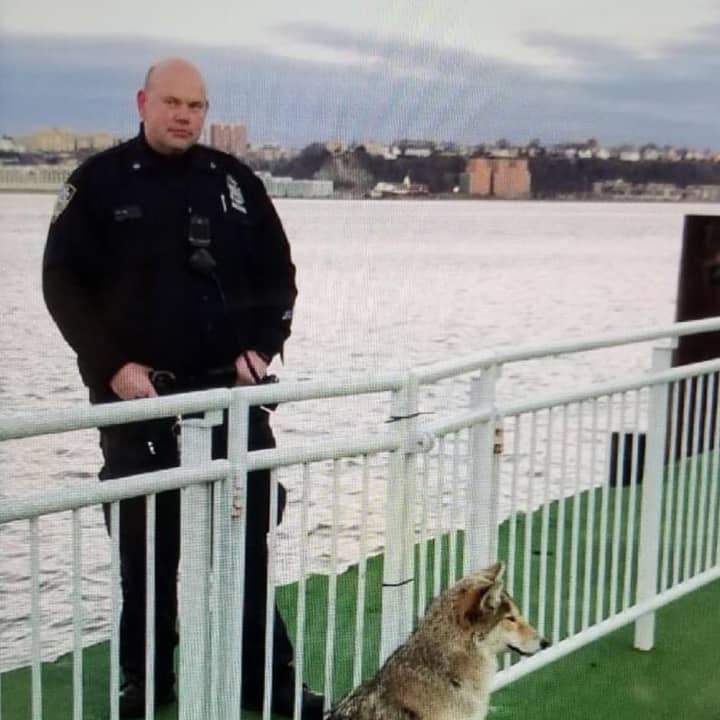Members of the New York Police Department received a report early on Sunday morning, Dec. 23 of the “vicious animal,” prompting the response.
Police said that first responders were able to barricade the coyote on Pier 59 in Chelsea with barriers and the NYPD’s Emergency Services Unit was able to safely tranquilize it. Once subdued, police were able to transport the coyote to the Brooklyn Animal Shelter without any harm or further incident.
It's possible the coyote came from Westchester.
The incident comes following several sighting in New Rochelle and Tuckahoe, where police and officials have been attempting to educate the public about the animal and its habits.
The coyote "taken into custody" in Manhattan on Sunday had reportedly been spotted in the streets of Harlem late Saturday night before heading south into midtown Manhattan.
According to the DEC, “coyotes are well adapted to suburban and even some urban environments, but for the most part they will avoid contact with people.
“However, conflicts with people and pets may result as coyotes tend to be territorial around den sites during the spring through mid-summer period as they forage almost constantly to provide food for their young.”
"Coyotes are an integral part of our natural ecosystem and provide many benefits to New Yorkers, but can cause conflicts if they become accustomed to human interaction and food sources," DEC Commissioner Basil Seggos stated. "We strongly encourage all New Yorkers to do their part and follow our common sense tips to ensure coyotes remain wary of people and minimize the chance of conflicts.”
The DEC has outlined a series of tips to reduce the risk of a potential coyote incident:
- Do not feed coyotes and discourage others from doing so;
- Unintentional food sources attract coyotes and other wildlife and increase risks to people and pets;
- Do not feed pets outside;
- Make any garbage inaccessible to coyotes and other animals;
- Fence or enclose compost piles so they are not accessible to coyotes;
- Eliminate availability of bird seed. Concentrations of birds and rodents that come to feeders can attract coyotes. If you see a coyote near your bird feeder, clean up waste seed and spillage to remove the attractant;
- Do not allow coyotes to approach people or pets;
- Teach children to appreciate coyotes from a distance;
- If you see a coyote, be aggressive in your behavior - stand tall and hold arms out to look large.
- If a coyote lingers for too long, then make loud noises, wave your arms, and throw sticks and stones;
- Do not allow pets to run free. Supervise all outdoor pets to keep them safe from coyotes and other wildlife, especially at sunset and at night. Small dogs and cats are especially vulnerable to coyotes;
- Fenced yards may deter coyotes. The fence should be tight to the ground, preferably extending six inches below ground level and taller than four feet;
- Remove brush and tall grass from around your home to reduce protective cover for coyotes. Coyotes are typically secretive and like areas where they can hide;
- Contact your local police department and DEC regional office for assistance if you notice that coyotes are exhibiting "bold" behaviors and have little or no fear of people. Seeing a coyote occasionally throughout the year is not evidence of bold behavior, and;
- Ask your neighbors to follow these same steps.
The Humane Society of the United States notes that residents who may spot a coyote in the area should "relax."
"If you spot a coyote in your neighborhood, relax: Most coyotes avoid people. Seeing a coyote out during the day is not a cause for alarm, especially in the spring and summer when they’re looking for food for their pups,” Lynsey White Dasher, HSUS director of humane wildlife conflict resolution, said. "Coyotes may mistake small, unattended pets as prey or attack large dogs they view as threats to territory or dens.
"If a coyote displays no fear of people, he’s probably been fed. You can reinstill his fear by raising your arms and yelling to drive him away. This is called hazing. Unlike trapping, which sometimes catches pets or other wildlife but rarely the coyotes who are causing problems, hazing works."
Click here to follow Daily Voice Mount Pleasant and receive free news updates.


